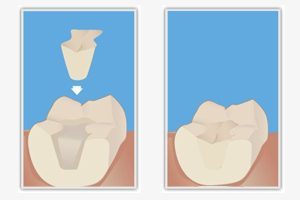Porcelain Inlays and Onlays
Porcelain Inlays and Onlays Cheltenham
 Inlays and onlays are restorative options to replace lost or damaged tooth parts, with artificial non-corrosive materials such as porcelain.
Inlays and onlays are restorative options to replace lost or damaged tooth parts, with artificial non-corrosive materials such as porcelain.
They serve the same goal as dental fillings and crowns but cover much larger areas of decay. They are used to restore a tooth, typically damaged by infection or breakage.
Inlays and onlays are required when teeth are weakened or have been extensively restored.
Inlays are used to repair a small amount of tooth structure lost due to decay. Like fillings, inlays fit inside the tooth.
Onlays also fit between the cusps of the tooth but extend to the chewing surface of a back tooth to replace one or more cusps.
Advantages of Inlays and Onlays
The following are the benefits of inlays and onlays:
- Minimal removal of tooth enamel is required.
- They last longer than other procedures such as dental fillings.
- Unlike fillings, they do not shrink, expand, or move around when exposed to changes in the temperature.
- They are more stain-resistant compared to other dental restorations.
The Inlay and Onlay Placement Procedure
Receiving an inlay and/or onlay for your damaged tooth usually takes two dental appointments.
- Once your dentist has assessed that you are a qualified candidate for the treatment, the affected tooth is then prepared.
- The decayed/damaged part of the tooth is removed, and the tooth is properly cleaned.
- Your dentist takes impressions of the tooth, which are sent to a dental laboratory for the fabrication of the restoration.
- A temporary restoration is attached in place to cover the tooth while your inlay/onlay is being manufactured.
- During your second appointment, the finished direct composite resin is bonded and fitted into place.
Frequently Asked Questions
When do you need restoration?
When a tooth becomes chipped, cracked, or develops decay, your dentist may suggest a crown, or even an inlay or onlay.
Treating the tooth early can help prevent complications, such as infection or abscess, helping patients avoid severe pain and the risk of tooth loss.
What are inlays and onlays?
Inlays and onlays are restorative solutions for teeth that have developed decay. Inlays are smaller, and they will go in the middle of the cusps on the biting surface.
Onlays are larger, and they can cover more than one cusp at the same time. Some can cover the sides of the tooth and the whole biting surface.
They will usually go on the back teeth, as these have larger biting surfaces.
Are inlays and onlays safe?
Placing a direct composite resin is generally considered safe, so there’s nothing to worry about.
How are inlays and onlays different from fillings and crowns?
The inlays and onlays are more durable than a traditional filling, and they can be used to cover larger areas of decay. They are smaller than crowns, and they require less enamel removal.
Do inlays and onlays need special care?
Inlays and onlays do not need any special care, so it is not a hassle to keep them clean.
They can be maintained with proper oral hygiene practices and regular visits to your Cheltenham dentist.
How long do inlays and onlays last?
With proper care and regular dental visits to your dentist, inlays and onlays generally do not need to be replaced for 20 to 30 years.
Porcelain Inlays and Onlays in Cheltenham
If you have one or more teeth that are worn, damaged, or infected by a cavity, Captivate Dental can fix the problem with custom-made, lifelike dental restorations, such as inlays and onlays.
Porcelain Inlays and Onlays in Cheltenham
For more information on porcelain inlays and onlays in Cheltenham, call us on (03) 9553 1249. Visit us on the web, or use our convenient online booking page.
We are located at 36 Chesterville Road in Cheltenham.
